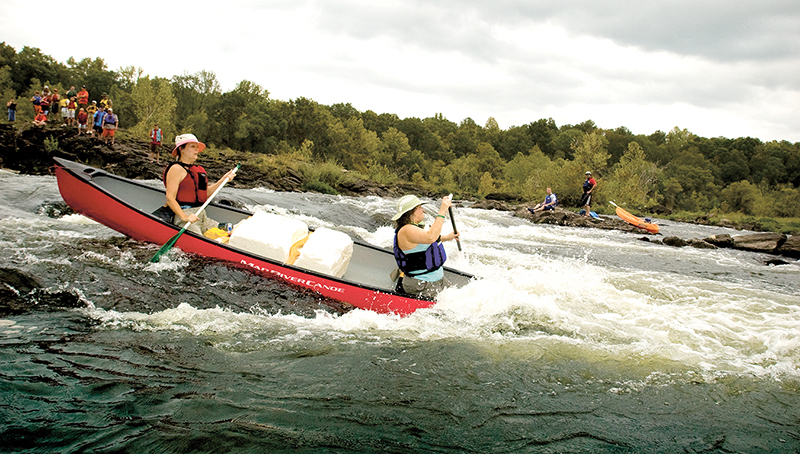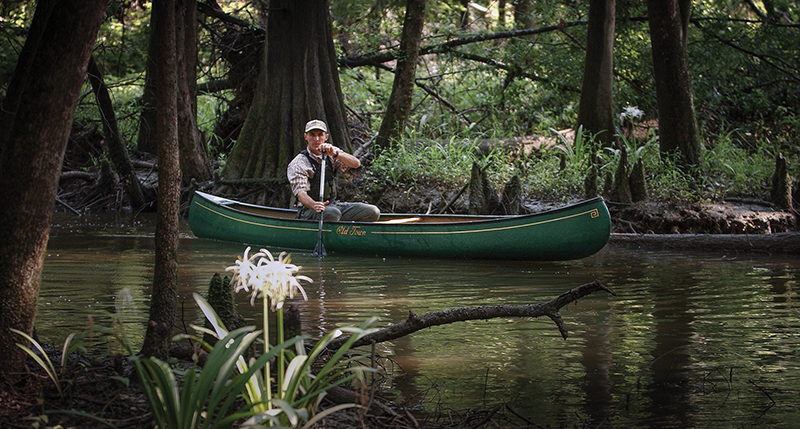Program preserves vital disappearing habitat for all
By John N. Felsher

Each year, more than a million outdoors enthusiasts traverse a state blessed with an incredible variety of habitats from tidal marshes to mountaintop forests. Many of them visit the more than 1.3 million acres of public land in Alabama. Many sportsmen hunt on 37 state wildlife management areas totaling more than 775,000 acres.
The state of Alabama owns some wildlife management areas, but leases significant acreage from timber companies or other large landowners. As part of the lease, these landowners permit the Alabama Department of Conservation and Natural Resources to manage the properties for public use. However, companies change ownership, leadership or focus periodically. Consequently, the state sometimes loses access to formerly public properties. When the state loses wilderness lands previously open to the public, those lands frequently disappear forever.
Fortunately, the state controls thousands of acres in the Forever Wild program. As the name implies, these properties will never go under a bulldozer or concrete, but will remain natural and forever open to the public for recreation.
“Forever Wild is a state operated land acquisition program with the purpose of securing lands for public recreation as wildlife management areas, state parks, nature preserves or recreational areas,” says Chris Smith, the ADCNR state lands manager in Montgomery. “Some WMAs draw a lot of out-of-state people who come here to hunt. They spend a lot of money. With leased property, we’re constantly under the possibility of losing parcels. Lands in Forever Wild are state-owned properties that we can preserve and keep forever wild.”
Forever Wild began with a constitutional amendment approved by the voters in 1992. In 2012, 73 percent of the voters reaffirmed their desire to keep the program going. Since 1992, the program set aside more than 241,000 acres in 25 counties for an array of public recreational activities. Besides hunters and fishermen, many hikers, boaters, paddlers, horseback riders, cyclists, bird watchers, history buffs and other outdoors enthusiasts visit these lands each year. The system includes more than 220 miles of hiking trails plus numerous canoe trails among other recreational opportunities.
“Not all Forever Wild properties are wildlife management areas, but roughly 88 percent of the Forever Wild Land Trust property is within a WMA somewhere in the state,” Smith says. “About three percent are additions to other historic parks or nature centers. Less than one percent of those properties are additions to existing state parks. The rest are not quite big enough to be in the WMA system, but we manage them as nature preserves and recreational areas.”
The system includes caves, mountainous habitat, coastal prairies, marshes, swamps, rivers – just about every habitat type found in Alabama. Some major proprieties in the system include Barbour, Cahaba River, Coosa and Perdido WMAs. One of the best public deer hunting properties in the state, Barbour WMA covers 28,199 acres near Clayton in the transition zone between the Black Belt Region and the coastal plain of southeastern Alabama. It frequently produces whitetail bucks exceeding 200 pounds.
“In 2006, Field and Stream magazine named Barbour WMA one of the top whitetail destinations in the nation,” notes Bill Gray, the ADCNR wildlife biologist for that part of the state. “It has some hardwood drains, upland pines, swamps, hills and hollows.”
The William R. Ireland/Cahaba River WMA covers 40,504 acres in Bibb and Shelby counties near West Blocton. Coosa WMA spreads across 32,624 acres of Coosa County near Rockford along the Coosa River. The Perdido River WMA includes 17,337 acres on the Alabama side of the Perdido River, which separates Alabama from Florida near Gateswood.
“In July 2014, we closed on a 460-acre parcel adjacent to a county park in Shelby County that has river frontage along the Cahaba River,” Smith says. “We’re thinking about putting in some canoe launches and take-out points. That’s a beautiful river to float. We’re looking to open a canoe trail that will span about 19 miles along the Perdido River in 2015. We’re working to improve some roads that will provide good access to trailheads, plus canoe put-in and take-out points.”

Preserving irreplaceable properties and habitats
At Blakeley State Park near Spanish Fort, visitors can walk among fortifications used by Union and Confederate soldiers when they fought one of the last major battles of the Civil War in April 1865. Many of these fortifications still look almost exactly like they did when the war ended a few weeks later.
Sometimes called the Grand Canyon of the South, the Walls of Jericho area in Jackson County holds some of the most scenic and ecologically significant property in the state. Five tracts totaling about 16,363 acres sit adjacent to James D. Martin-Skyline WMA near Scottsboro along the Tennessee state line. About 200 years ago, Davy Crocket hunted these hills and valleys. Today, hikers, photographers, birdwatchers and horseback riders can explore numerous trails or follow the gorge along the Paint Rock River.
“We try to preserve unique, irreplaceable properties and habitats, like the Mobile-Tensaw Delta,” Smith explains. “We also do some habitat restoration work on some properties, such as replanting them in native vegetation. Some properties are already beautiful, unique properties, but it’s rare to find a Forever Wild property that doesn’t need some type of enhancement or restoration.”

Practically in the shadow of downtown Mobile, the Mobile-Tensaw Delta spreads across about 250,000 acres of wilderness, second in size only to the Mississippi River for river delta wetlands in North America. Forever Wild preserves more than 50,000 acres in this maze of bayous, creeks, lakes, swamps, marshes and estuaries. In 1974, Congress declared the delta a National Natural Landmark.
From north to south, the delta transitions from bottomland hardwood forests pockmarked by numerous streams and lakes to cypress swamps. The lower delta opens into an enormous network of bays and bayous bordered by fresh and brackish marshes at the northern edge of Mobile Bay. The area provides homes to one of the largest concentrations of black bears in Alabama, plus numerous waterfowl, wading birds, raptors, whitetail deer, otters, alligators and many other creatures.
The Forever Wild program also tries to preserve or restore habitat vital to endangered species. For instance, the program owns two tracts in Monroe County totaling 4,376 acres that provide crucial habitat for endangered Red Hills salamanders plus other rare plants and animals. The Red Hills Tracts consist mainly of upland pines and mixed forests north of Monroeville.
“The Red Hills Tracts were commercial timber properties when Forever Wild bought them,” Smith says. “We’re restoring the habitat to what it was and monitoring the salamanders.”
The Forever Wild Land Trust does not take private land away from owners. In fact, the law specifically dictates that Forever Wild can only buy land from willing sellers, but anyone can nominate a property as a Forever Wild candidate. After a review process, the state can then make an offer to buy the property at fair market value.
Once a property becomes part of the Forever Wild system, state land managers determine what to do with it. They might create a wildlife management area, public park or other recreational facility. Then, property managers plan what enhancements or restorations they want to do such as building hiking or canoeing trails.
“We’re always looking for new acquisitions,” Smith advises. “We’re close to closing on about 3,000 acres along the Sipsey River in Tuscaloosa County. There’s already a 3,000-acre tract along the Sipsey River. It’s very popular for hunting and horseback riding. We should be able to add that new property to Forever Wild in the next four to six months. That’s going to give us about 40 river miles on the Sipsey where we can put in some canoe launches and take-out points. People will be able to float down the river and hunt or fish.”
For more information on the Alabama Forever Wild program and to see an interactive map of the properties, visit alabamaforeverwild.com.
[box]
How you can help preserve more valuable habitat
By John N. Felsher
Forever Wild does not receive any tax dollars. Money for the Forever Wild Land Trust fund comes from interest earned by the Alabama Trust Fund, mostly through monthly royalty payments from oil and gas extraction. The program receives 10 percent of that interest annually, up to $15 million.
 People can also help fund Forever Wild programs and preserve more land by buying a Friends of Forever Wild car license plate. Most of that money goes directly toward the purchase of properties for the Forever Wild system. These lands could become part of an existing park, wildlife management area, historical area or a separate nature preserve.
People can also help fund Forever Wild programs and preserve more land by buying a Friends of Forever Wild car license plate. Most of that money goes directly toward the purchase of properties for the Forever Wild system. These lands could become part of an existing park, wildlife management area, historical area or a separate nature preserve.
Anyone who buys a Forever Wild car tag directly supports Forever Wild land acquisitions,” explains Chris Smith, the Alabama Department of Conservation and Natural Resources lands manager. “All of that money goes directly to the land acquisition fund to protect our Alabama natural heritage.”
To learn more about this program, click HERE.
[/box]




